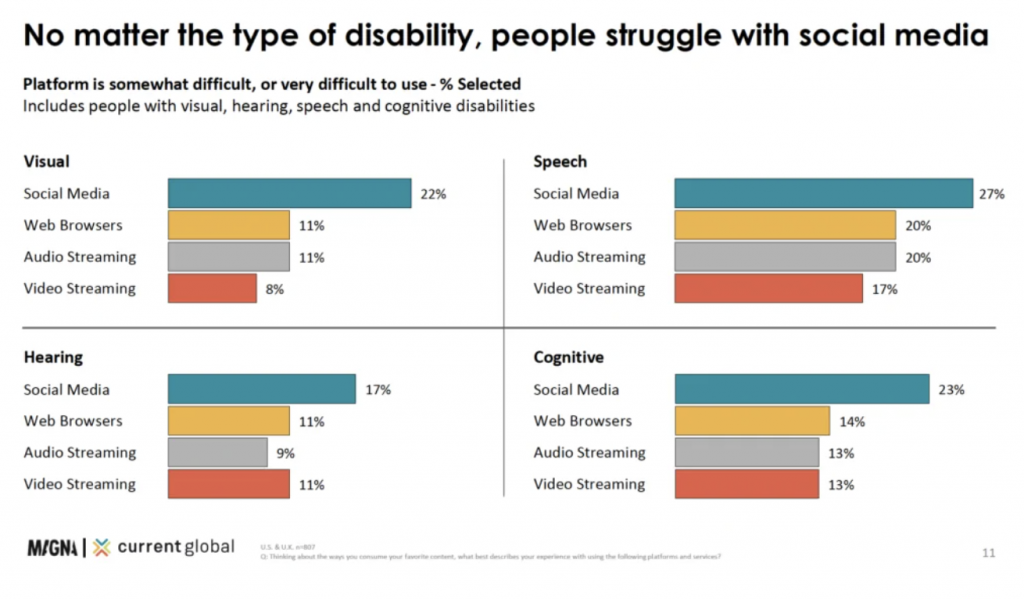By Kyle O’Brien, published by AdWeek
Many still have trouble accessing content easily
One glaring oversight is leading many marketers to fail to connect with a substantial audience.
A recent study found that brands need to prioritize accessibility and inclusivity in their communications planning to more effectively reach people with disabilities.
Communications agency Current Global, media investment and intelligence company Magna and IPG Media Lab conducted the “Digital Accessibility: The Necessity of Inclusion” study, which found that while people with disabilities, representing 15% of the global population, consume all types of media, many of those people have trouble accessing content comfortably and easily.
Missed Connections
People with disabilities have a collective global buying power of $8 trillion and represent a significant audience that marketers may be excluding by default or by design. Consider these numbers cited in the study:
- 285 million people are visually impaired; 39 million are blind and 82% of all blind people are age 50 or older.
- 466 million people have disabling hearing loss; by 2050, that number will rise to over 900 million.
- Between 1-3% of the population have an intellectual disability, as many as 200 million people; intellectual disability is significantly more common in low-income countries—about 16 in every 1,000 people.
- About 18.5 million people have a speech, voice or language disorder.
That’s a relatively large segment of the population that isn’t been served properly by marketers.
The study participants were from the U.S. and the U.K. and had visual, hearing, cognitive or speech disabilities. This segment of the population consumes all forms of media, including visual content like TV, social media and short online videos, but social media platforms can be difficult to use for people with all types of disabilities. Problems include small text, misleading buttons, ads interfering with posts, too many menu options and difficulty of navigation.
Building a Better Toolbox
The study comes amid a broader shift toward inclusivity in marketing budgets.
“Content is published every day that’s inaccessible to many, but it doesn’t have to be that way,” George Coleman, co-CEO of Current Global, said in a statement.
The agency made a commitment in December that every piece of communication developed, curated or published on behalf of the firm and its clients should meet the highest accessibility standards.
“If brands don’t adjust their communications strategies to reach all audiences, they will miss out on forging long-lasting relationships with a large population of consumers,” Coleman said.
While some companies are working to make their products more accessible, as evidenced by Microsoft’s 2019 Super Bowl ad celebrating gamers using the Xbox Adaptive Controller, the study found that assistive tools, like readers, aren’t always the best answer. Sixty-four percent of respondents reported problems consuming content even with an assistive tool, and 34% had problems consuming content because of the tool itself. Also, 56% of the overall audience needs assistive tools but doesn’t have access to them, citing cost as a major issue.
The study also showed that lack of accessibility has become normalized. While 40% of the general public thinks brands are doing a good job, the standards are low and brand sentiment could be at stake. Inaccessible communications can cause negative emotions and reactions to brands, while accessible messaging can lead to positive brand engagement.
The study offered guidelines for brands, including not overlooking accessibility when it comes to communications, improving content and assistive tools, and stressing accessibility in communications planning.
“It’s astounding how much work still needs to be done to make communications accessible to people with disabilities,” Kara Manatt, svp, intelligence solutions, Magna, said in a statement. “This audience is consuming a lot of content, so brands need to ensure they put in the work to make communications more accessible. Assistive tools are only part of the solution—if communications aren’t accessible, the tools can’t really be effective.”


